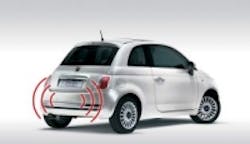Advanced driver assistance systems to drive image sensor growth
Machine vision system sales, including image sensors, continue to rise and are expected to do so over the coming years. One particular area of potential significant growth for image sensors is in automotive applications such as advanced driver assistance systems (ADAS), according to a new market research report from Smithers Apex.
ADAS applications utilize image sensors to provide enhanced safety features on the road by offering features such as parking assistance, lane departure warnings, and collision avoidance systems. As the technology for ADAS has progressed, the price point for it has concurrently decreased. For example, a parking assistance system in the Lexus LS400 used to cost roughly $3,000, but now, the same feature is a $395 option in mainstream Ford vehicles.
As a result, the market for ADAS system is growing. An analysis from Smithers Apex shows a potential compound annual growth rate of more than 50% until 2018, with a potential market value jump from the current value of approximately $18.5 billion to $165 billion in five years. The report cites a number of different sensors deployed in today’s ADAS systems, but indicates that the most common environmental near and far-field monitoring systems use radar, lidar, ultrasonic, photonic mixer device (PMD), camera, and night vision sensors.
In addition to expanding technology and decreased costs, another reason for the growth of ADAS systems is national safety initiatives. The European New Car Assessment Programme (Euro NCAP), for example, launched a reward program called "Euro NCAP Advanced" to promote adoption of advanced safety techniques. It also recently announced that only cards with ADAS systems would be awarded a top 5-star safety rating.
In the United States, the key safety goal of the US Federal Motor Carrier Safety Administration (FMCSA) is to reduce the number of commercial motor vehicle (CMV) crashes. FMCSA has been working in collaboration with the truck industry to test, evaluate, and facilitate the use of on-board safety systems for CMV crashes in order to improve the safety of all drivers. In addition, the National Highway Traffic Safety Administration’s Safecar initiative will drive regulatory adoption of ADAS systems in domestic vehicles. With these developments, the need for ADAS systems has increased, which has placed a greater burden on developers of these systems.
Lastly, a geographical analysis shows that the United States and western Europe still represent the major ADAS markets, but countries such as China, Japan, and South Korea are expected to make driver assistance systems mandatory, which would also contribute to the overall growth in the market.
View the press release on the report.
Also check out:
VISION roundtable provides insight on global machine vision market
Report: CMOS image sensor market to reach $13 billion by 2018
Live updates from the AIA Business Conference
Share your vision-related news by contacting James Carroll, Senior Web Editor, Vision Systems Design
To receive news like this in your inbox, click here.
Join our LinkedIn group | Like us on Facebook | Follow us on Twitter | Check us out on Google +
About the Author

James Carroll
Former VSD Editor James Carroll joined the team 2013. Carroll covered machine vision and imaging from numerous angles, including application stories, industry news, market updates, and new products. In addition to writing and editing articles, Carroll managed the Innovators Awards program and webcasts.
